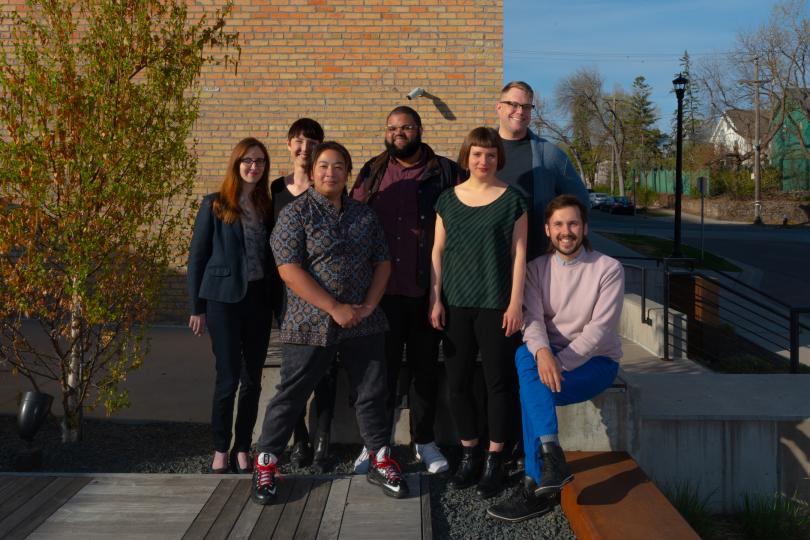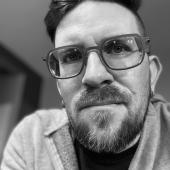Carrying a legacy forward

On April 30th Red Eye Theatre announced the appointment of seven new artistic directors continuing the organization's artist led model established and sustained by co-founders Steve Busa and Miriam Must. Their announcement to pass the torch was unfortunately overshadowed by the loss of the building just south of downtown Minneapolis which formerly housed the organizations nearly 35 years of work. Red Eye’s new leadership includes Andrew Lee Dolan, Hayley Finn, Emily Gastineau, Rachel Jendrzejewski, Theo Langason, Valerie Oliveiro, and Jeffrey Wells.
The following is an interview conducted over email with the new artistic directors.
Damon: Red Eye Theater was pretty deliberate in their intent to transition leadership to a new model, talk about how this new team emerged and some of the challenges in bringing the group together.
Emily: That’s right! As with all things, Red Eye co-founders Steve Busa and Miriam Must did not approach the leadership transition in a conventional manner. As they started to contemplate their retirement, they brought together a group of artists who had developed work at Red Eye in recent years, in order to envision what the future of Red Eye could look like. The proposal for collaborative leadership came out of this group, when we asked ourselves how the artistic processes that live at Red Eye could be thoroughly integrated into the model of the organization. Some of the seven artistic directors were involved with this advisory group, and others came on board later on to balance out our different skill sets, interests, and backgrounds.
Jeffrey: It also felt really important to me, and I think to most if not all of us (though as I’ve learned from my work with SuperGroup, in a collaborative it is important to be clear about when you are speaking for yourself and when you are speaking for the group) that we continue the practice Miriam and Steve started of having Red Eye be led and administered by working artists. The running of an arts organization is no small feat, and is arguably getting more complicated as the funding structures and ecosystem for performance changes. Taking the step to expand the leadership team seemed like a good way to meet the demands of the new normal for Red Eye, while simultaneously allowing each of us to continue to deepen our individual artistic practices.
Rachel: I just want to underline that we’re under no illusions about the challenges inherent to collaborative leadership! Right now, we’re deep in conversation about many of the essential starting points--which, of course, are the same things that (hopefully) get addressed at the top of any new collaborative artistic process--such as how we communicate, how decisions get made, how we handle conflict, how we relate to money. Currently, we’re each taking lead on different branches of the administrative work, always working in tandem with at least one other person in any particular area. All of this comes with an understanding that much of what we establish during this transitional moment may evolve or even totally change as we grow into this new model together.
Damon: What is the vision for the new Red Eye Theater?
Theo: As a group, we have rallied around experimentation, collaboration, and critical discourse to drive the vision for Red Eye. These practices were stitched through Steve and Miriam’s 35 years of work, and the seven of us are committed to carrying them forward.
Valerie: For us, experimentation means always questioning, excavating assumptions about form and content, and valuing the wildness of artistic process. Collaboration is integral to this as well--mixing perspectives, disciplines, and backgrounds, and welcoming unexpected results when we tackle something together. Critical discourse is an everyday practice at Red Eye, particularly through the feedback protocols developed by Steve and Miriam.
Theo: There’s also a lot of potential to carry these conversations about work into more public spaces, and foster dialogue about contemporary performance and its interaction with the world.
Damon: What elemeents of Red Eye's history, culture, and traditions were important to maintain in the new vision?
Rachel: As Jeff already mentioned, it felt important to continue the practice that Miriam and Steve established of having Red Eye be an artist-run organization. We each already had a commitment both to creating work and supporting or mentoring other artists, independently and through our work with other organizations (including Mn Artists, Blackout Improv, The Cowles Center, Bedlam Theatre, Project Success, SuperGroup, Fire Drill, DanceMN, The Playwrights’ Center, Sandbox Theatre, Walker Art Center, and Upstream Arts), so we all felt very connected to this particular Red Eye tradition. That means that, in the coming years, all of us will be developing and presenting our own work at Red Eye, as well as continuing to support work by other artists through the New Works 4 Weeks Festival and other programs.
Emily: We are also continuing to use the Red Eye feedback protocols, some of which are related to Liz Lerman’s Critical Response Process but adapted by Steve and Miriam in their own process over the years. At the same time, we are thinking critically about what types of dialogue that different feedback protocols can prevent or enable, and how to acknowledge the positionality of every viewer when responding to work. So the spirit of critical discourse continues, but we look critically at that as well.
Damon: Similarly, what were some key elements of the history, culture, and traditions that needed updating, or a new approach?
Emily: Continuing on that thread of criticality--though we named experimentation, collaboration, and critical discourse as key values for Red Eye across its whole history, we are committed to continually asking ourselves what those things mean today, what they will mean a year from now, three years from now, ten years from now. If we can stay responsive to these questions through our artistic practices, and keep our finger on the pulse of how the arts landscape and wider culture are always changing, we hope we can let this influence the processes of the whole organization.
Andrew: Like many arts organizations founded by white artists, we know that Red Eye has significant room for improvement in addressing racial equity. It’s important for Red Eye that artists of color take on leadership roles within the organization, and that Red Eye puts significant resources towards supporting the practices of BIPOC artists--and allowing that work to have an impact throughout the organization. This is an ongoing responsibility, especially for the artistic directors who are white. We are also working to put more intention around the inclusion of artists and audiences with disabilities, and looking at how this will change our practices across programming, communication, application processes, finances, etc.
Damon: How was the slate of initial artists and productions selected (for the upcoming Works-In-Progress 2019)?
Theo: The artistic directors selected the artists for this year’s New Works 4 Weeks Festival. As in previous years, the Works-in-Progress cohort was selected through an application process (we had a record number of applicants this year!) and a panel including past festival artists and some (but not all) of the artistic directors. The Isolated Acts artists were curated directly, drawing from artists who have participated in Works-in-Progress in past years, as well as some artists new to Red Eye whose work we’ve followed, plus the two artistic directors who had not previously shared their work in Isolated Acts. Across the whole festival, we look for a nice mix of theater, dance, music, and interdisciplinary performance, and for artists whose work engages with experimentation, collaboration, and critical discourse--though we hope to be surprised by how that might be expressed!
Hayley: When selecting the artists this year, we were looking to support artists who were asking tough questions both in content and form, artists that were interested in challenging themselves with a fearless yet thoughtful approach to making work. We were also looking for artists who were open to being part of a critical discourse process and who we felt could benefit from being in conversation with one another.
Jeffrey: Moving forward I think both the panel process for WIP and the curatorial process for Isolated Acts are good things for the ADs to look at and possibly update. I’d love to continue to make sure that more and more artists know about these programs, and to create more clarity around how to access opportunities at Red Eye.
Damon: What are some of the biggest challenges the organization is facing at this point and how do you plan to tackle them?
Andrew: The biggest curveball has been that Red Eye’s planned leadership transition ultimately coincided with the loss of our space. In March 2018, we were informed of our landlord’s intent to sell Red Eye’s longtime home in the Loring Park neighborhood to developers, who are constructing luxury condos in its place. Because the sale violated the terms of Red Eye’s lease--and thanks in large part to our board member David Kelley, a senior real estate attorney--a small settlement was negotiated that will support the transition to a new space. Red Eye moved out of the West 14th Street space in October 2018 and will be holding programming in other venues until we secure a new space.
Valerie: It’s pretty widely acknowledged that we are in a space crisis at the moment, after the recent loss of several key performance spaces and arts organizations in the Twin Cities, and others on shaky ground. This is a challenge for the whole local performing arts field, which we are all a part of--so we as a community need to figure out how to reorganize ourselves around this new landscape. Red Eye has a great opportunity, and a great responsibility, to step into that space, gather a wider network of artists, and continue to support artists making experimental performance.
Damon: What excites you most about the future of Red Eye?
Valerie: We are really excited about the potential for Red Eye to develop into a true hub for contemporary performance in the Twin Cities--to experience the kind of vitality, connection, and exchange that can happen when artists share space together. There is so much rigorous work being made in the Twin Cities, and we want to make that work more visible. Between the seven of us, we have a very broad network of other artists and contexts--and we want to put our colleagues in conversation with those people and places too. In this way, we are building the scene that we want to be a part of, that we want to nurture our own work and push it to new places.
Damon: What would yo ulike people to know about the new Red Eye Theater that isn't necessarily contained in marketing or the press relesae?
Hayley: The ethos of Red Eye is to encourage artists to embrace risk and chase their artistic impulses. Even though we are a small and scrappy organization, we don’t let that squelch artistic ambition.
Andrew: Absolutely. Steve and Miriam set an amazing precedent of (almost) always saying yes to artists first--and that’s the spirit in which we want to continue.
Red Eye Theater Presents: New Works 4 Weeks Festival
This incubator of new work has become a cornerstone of the Twin Cities performance landscape, culminating in a showcase of the freshest experiments from Minnesota’s most risk-taking performing artists.
May 30-June 2: Works-in-Progress, with Rebekah Crisanta de Ybarra | Julia Gavin Bither & Claire King | Casey Llewellyn & Morgan Thorson | Megan Burns & Ricardo Beaird | Annika Hansen, Nakita Kirchner, Anusha Ramaswami, Nicole Stumpf, & Abigail Whitmore
June 6-8: Anna Johnson | Arneshia Williams
June 13-15: Theo Langason
June 20-22: Valerie Oliveiro | Pedro Pablo Lander
The TEK BOX at The Cowles Center (528 Hennepin Avenue Minneapolis, MN 55403)
Tickets: $10-15
Thurs-Sat 8 pm (Sun, June 2 at 7 pm)
Tickets/Info: www.redeyetheater.org




